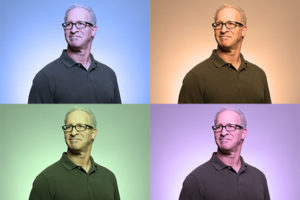I Can Make My Video Myself, Right?

The third reason why going it alone is a bad idea.
The budget is one of the most common concerns when it comes to a video for your practice. Video done well is expensive. In an attempt to cut costs, it can be tempting to use your webcam to shoot your own video. It’s so easy. After all, if it’s good enough for a webinar, maybe it’s good enough for a video, right?
The short answer is, “it’s not.”
One of the longer answers is about the lighting, and more specifically, the color temperature.
As Americans, we’ve been marketed to our entire lives, and we’re actually pretty good at picking it out. So, it should come as no surprise that colors are used to affect us psychologically. For example, research shows that warm colors tend to attract spontaneous purchases. That’s one of the reasons fast food restaurants tend to use red a lot.
Film makers do it, too. Blue tends to make people feel cold, harsh, and hard. Orange and yellow make people feel warm and cozy. Green makes people feel uneasy.
When it comes to using your webcam, that harsh blue light from your computer screen is not doing you any favors when you want people to be at ease and trust you. And the greenish hue from the mercury vapor in those overhead fluorescent light bulbs is only making it worse.
This is not an easy problem to fix, either, as getting neutral white light is a lot harder than it seems. If you’ve ever bought a “white” light bulb at a big orange store, you know that white is not necessarily white. There’s “daylight,” “cool white,” “warm white,” “tungsten,” etc. All of these are marketing words to describe the more technical, but more accurate description of color temperature measured in Kelvins (K).
To get technical, white falls in the color temperature spectrum roughly between 2700K-5600K. The lower the temperature, the more yellow the light, and the higher the temperature, the more blue the light.
So, ironically, what we normally refer to as “warm” light as more yellow/orange tint actually has a cooler temperature measured in K, and conversely, what we refer to as “cool” blue light actually has a warmer temperature in K.
Confused yet? It gets better.
In the old days, when video cameras were still film cameras, they would select a totally different film stock based on whether they were going to be shooting in full sunlight, cloudy skies, or with studio lighting (using tungsten filaments). Ever since digital cameras came out, you don’t have to worry about film stocks, but you still have to tell the sensor what to call white.
Problem is, however, most consumer-grade cameras (which includes your iPhone and your webcam) will adjust the color temperature “automatically,” which is marketing-speak for “we don’t offer manual white-balancing.” And what’s worse, many of them aren’t sophisticated enough to know when you’re recording, and they will adjust the color balance in the middle of your video if it senses a different color source.
If you’ve done the work up to this point to identify the emotion that you want to evoke in your video, a good video production company will know what color palette to use and they’ll have the right equipment that allows them to dial that in. Without a working knowledge of color temperature and the psychological impact of color theory, you could be sending mixed messages to your audience concerning what you want them to think and feel.





